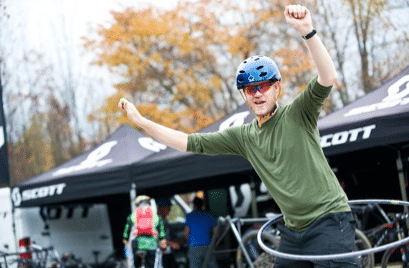
A Newbie’s Guide to Mountain-Biking
In the spring of 2014, Charles Schindler gave up his dental practice to pursue his true passion: teaching mountain-biking. A frequent instructor at the Midwest Women’s Mountain Biking Clinic, Schindler travels the Midwest in his camper emblazoned with his Sheltowee Fundamentals logo and teaches frequent lessons and mini clinics.
What gear do you need to get started?
A helmet! No, we didn’t wear them as kids, but we should have. With the new knowledge we have about the health effects of traumatic brain injuries, you’d be a fool not to wear a helmet.
You also need a safe bike that has been checked by a mechanic. Wider tires with knobs are the best. Nothing too fancy required. The bells and whistles will follow once you’re hooked on riding.
A small toolkit and a way to change a flat tire (tire lever, tube, patch kit, and pump).
Lastly, a way to carry water, whether it’s a bottle or hydration pack. A hydration pack is simply a backpack with a pouch to hold water and a tube to drink from while riding.
Once you have these “specialty” items, anyone can enjoy a mountain-bike ride.
What are the first lessons you teach to newcomers to the sport? Why are they so important?
The first thing I like to cover is how to do a safety check of your bike before a ride. Nothing advanced, just a few things to make sure you’re safe for the ride and less likely to have a mechanical problem.
After safety, I move on to skills instruction. I teach skills in a smooth, grassy field so that newcomers can focus on the skill itself, without technical terrain as an added complication. The first few skills deal with a rider’s body position on the bike, and how the bike moves underneath the rider while on the trail. By understanding body position, riders can improve their balance and are able to ride longer and on more difficult trails.
The next skill for new riders covers the bike’s shifting and how to use the gears correctly and efficiently. And since the gearing makes us go, braking is the obvious next skill, because stopping is definitely important.
What if I get in over my head on the trail? Will other riders think less of me if I have to get off my bike and climb over an obstacle?
I have found that if this is the case, you’re riding with the wrong people. And if you do perhaps run into this type of rider, it’s usually a result of misplaced ego or the effects of youth. I am a huge proponent that you should “ride your own ride.” We go on rides with groups for safety, but there should never be peer pressure to go outside your comfort zone. Try a new skill or obstacle in your own time, when you are comfortable.
What are the best local trails for a beginner?
In the Indianapolis area, I would suggest Southwestway Park or Fort Harrison State Park. Both are well-maintained and have a range of trail difficulty levels to accommodate both new riders and the more experienced crowd.
What’s your best coaching success story? Regret?
From a big-picture standpoint, I’d have to say my involvement in the Midwest Women’s Mountain Bike Clinic. I’ve coached every year but one, and that’s allowed me to meet a lot of great riders. It’s especially nice to see how many of the past participants continue to ride more, improve their skills, and increase their involvement in the cycling community. The only regret I have is that I didn’t start coaching sooner.
How did you get started riding? Why did you go into instructing newer riders?
I was the summertime lap kid. Whether in a campground or at home, I was always on the Schwinn, around and around, over and over. I got my first mountain bike when I started high school, and for the first four years, I was riding reclaimed coal mines and ATV trails in eastern Kentucky, making it up as I went. In college I was finally able to ride with other people and discovered single-track. It’s all been downhill— and uphill—from there.
The desire to help new riders was just a natural progression of a lifetime of riding. When you’ve gotten as much enjoyment from the bike as I have, there comes a time when you know you have to use the bike to give a little back. I’m not a stellar trail-builder, nor a politician or fundraiser. But I learned while teaching at the Midwest Women’s Mountain Biking Clinic that I could help people have more fun on two wheels in the woods. There’s nothing better than that big smile after someone rides a new piece of trail for the first time.
For more information, visit sheltoweefundamentals.com.





